

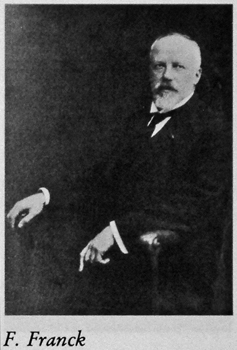 °17.05.1872 Antwerp - †23.03.1932 Ostend
°17.05.1872 Antwerp - †23.03.1932 Ostend 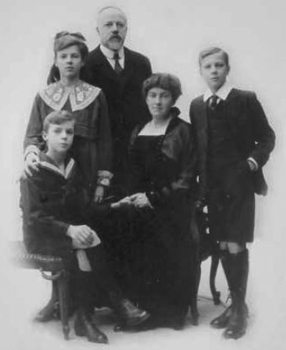 The reputation of the House of Franck can mainly be attributed to Frans' creative spirit, sharpness and talent. Moreover, he had a great power of persuasion. As a handy businessman, he was able on more than one occasion to persuade his customers to fully furnish their homes in the 'Franck style' (with silk wallpaper, Japanese lacquer and mother of pearl) or to purchase a number of exclusive furniture, which in turn led to an invoice, which - according to Franck - was always in proportion to the performance delivered. The following anecdote, recorded by Roger Avermaete, is, if not historically, typical: "Frans Franck, after having fully upholstered a newly built master house, suggested to the owner that he should be given another vault. To which Mr W..., who was very rich, would have replied with a smile: 'Once your bills will been paid, I would no longer need a vault"'.
The reputation of the House of Franck can mainly be attributed to Frans' creative spirit, sharpness and talent. Moreover, he had a great power of persuasion. As a handy businessman, he was able on more than one occasion to persuade his customers to fully furnish their homes in the 'Franck style' (with silk wallpaper, Japanese lacquer and mother of pearl) or to purchase a number of exclusive furniture, which in turn led to an invoice, which - according to Franck - was always in proportion to the performance delivered. The following anecdote, recorded by Roger Avermaete, is, if not historically, typical: "Frans Franck, after having fully upholstered a newly built master house, suggested to the owner that he should be given another vault. To which Mr W..., who was very rich, would have replied with a smile: 'Once your bills will been paid, I would no longer need a vault"'. 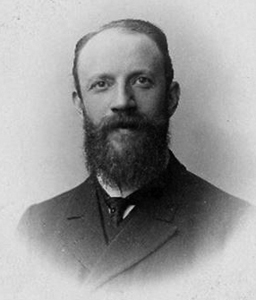 Frans Franck won the friendship of numerous artists from different disciplines, and gradually matured with him the plan to transform the former chapel of the godhouse Landtschot on the Falconrui, which he rented from the PCSW (Public Centre for Social Welfare), and used as a storage place for furniture, into a small art temple. Together with E. De Bom, J. Van Overloop, his brothers Charles and Louis Franck, R. Baseleer, Ch. Mertens, W. Vaes and others were thus at the basis of the association 'De Kapel', which was mainly involved in the organisation of lectures. Frans Franck also formed the basis of the 'Society of New Concerts' (1903-1936), which, together with Lodewijk Mortelmans, provided the music scene in Antwerp with wonderful moments.
Frans Franck won the friendship of numerous artists from different disciplines, and gradually matured with him the plan to transform the former chapel of the godhouse Landtschot on the Falconrui, which he rented from the PCSW (Public Centre for Social Welfare), and used as a storage place for furniture, into a small art temple. Together with E. De Bom, J. Van Overloop, his brothers Charles and Louis Franck, R. Baseleer, Ch. Mertens, W. Vaes and others were thus at the basis of the association 'De Kapel', which was mainly involved in the organisation of lectures. Frans Franck also formed the basis of the 'Society of New Concerts' (1903-1936), which, together with Lodewijk Mortelmans, provided the music scene in Antwerp with wonderful moments. 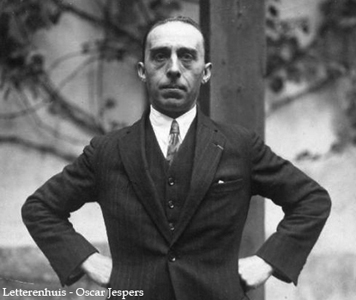
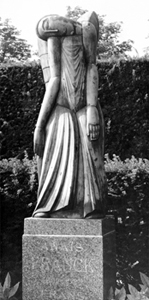 In 1927, Franck's wife Anaïs (Anna) Franck died.
In 1927, Franck's wife Anaïs (Anna) Franck died. 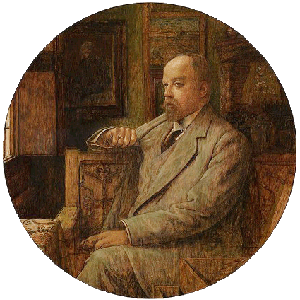 'François Franck - by Mertens Charles' - KMSKA
'François Franck - by Mertens Charles' - KMSKA  °11.05.1870 Antwerpen - †11.01.1935 Antwerpen
°11.05.1870 Antwerpen - †11.01.1935 Antwerpen 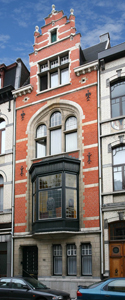 With a façade width of two bays, the row house comprises three floors under a combined limp saddle (slates) and flat roof. The molded façade has a red brick masonry in cross with wrought iron ornamental anchors, use of white natural stone for the façade, bacon coats, water frames, window frames, neg blocks, an archivolt, scaffolding holes, collar, top stones and top pieces, on a profiled blue brick plinth. Guided by a decorative frame, a wooden upstand responds to an axial design, crowned by a stepped, two-part roof window with double cross frame, overangular finials on corbels and ornamental balls as masterpieces. The emphasis is on the superstructure, which is successively marked by a three-sided wooden bay window with slate roof and a circular arched triple light, contained in a pointed savings with head blocks and profiled archivolt. The portal and a triple-light with stretched lintel on corbels break through the printed façade. A broken wooden cornice on modillions forms the façade finish. The wooden carpentry of the entrance door with its ornamental ironwork and the windows with small rocks in the top light have been preserved in their entirety.
With a façade width of two bays, the row house comprises three floors under a combined limp saddle (slates) and flat roof. The molded façade has a red brick masonry in cross with wrought iron ornamental anchors, use of white natural stone for the façade, bacon coats, water frames, window frames, neg blocks, an archivolt, scaffolding holes, collar, top stones and top pieces, on a profiled blue brick plinth. Guided by a decorative frame, a wooden upstand responds to an axial design, crowned by a stepped, two-part roof window with double cross frame, overangular finials on corbels and ornamental balls as masterpieces. The emphasis is on the superstructure, which is successively marked by a three-sided wooden bay window with slate roof and a circular arched triple light, contained in a pointed savings with head blocks and profiled archivolt. The portal and a triple-light with stretched lintel on corbels break through the printed façade. A broken wooden cornice on modillions forms the façade finish. The wooden carpentry of the entrance door with its ornamental ironwork and the windows with small rocks in the top light have been preserved in their entirety. 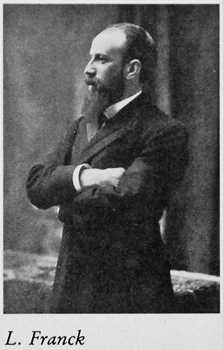 °28.10.1869 Antwerp - †31.12.1937 Wijnegem
°28.10.1869 Antwerp - †31.12.1937 Wijnegem 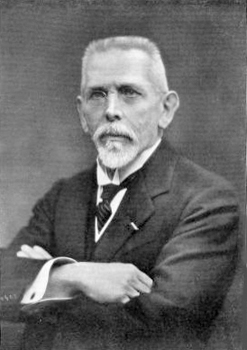 °24.07.1849 Antwerpen - †18.09.1939 Antwerpen
°24.07.1849 Antwerpen - †18.09.1939 Antwerpen 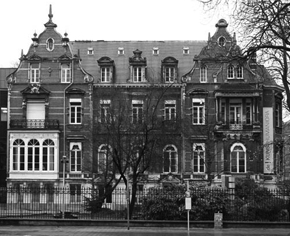 Halfway through the 19th century there was a villa between the Karel Oomsstraat and the Korte Lozanastraat. This district, around the 'Warande' (the actual King Albert Park), developed into an exclusive residential area in the second half of the 19th century, especially when, around the turn of the century, some of the most prominent German-Antwerp families settled there: Osterrieth, Kreglinger, Fuhrmann, Von der Becke…
Halfway through the 19th century there was a villa between the Karel Oomsstraat and the Korte Lozanastraat. This district, around the 'Warande' (the actual King Albert Park), developed into an exclusive residential area in the second half of the 19th century, especially when, around the turn of the century, some of the most prominent German-Antwerp families settled there: Osterrieth, Kreglinger, Fuhrmann, Von der Becke…
